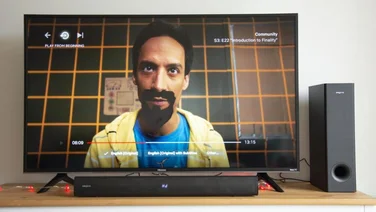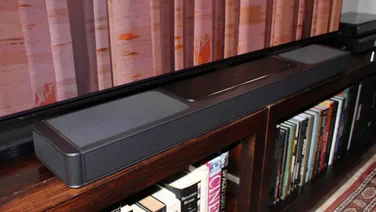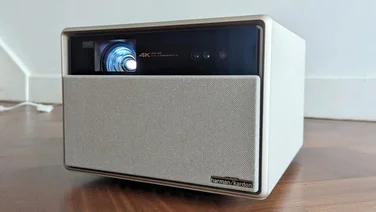To help us provide you with free impartial advice, we may earn a commission if you buy through links on our site. Learn more






- Ingenious transforming design
- Laser system enhances picture performance
- Incredibly convenient to set up and use
- Missing key catch-up TV apps
- Battery life still needs improvement
The XGIMI MoGo 4 Laser projector arrives on the scene as a high-end successor to last year’s MoGo 3 Pro and a step-up model from the basic MoGo 4 – and you can probably guess the key difference. It’s effectively the MoGo 4 with the LED light source switched out for a triple laser system, raising the brightness levels from 450 ISO Lumens to 550 ISO Lumens and delivering an improved 1000:1 contrast ratio.
Given that the biggest complaint we had about the MoGo 4 was that it didn’t go quite bright enough and lacked contrast in dark or gloomy scenes, this is very good news indeed. It’s good enough that the MoGo 4 Laser isn’t just a good portable projector, but arguably the best you can buy right now.
What do you get for the money?
The MoGo 4 Laser is priced at £679, which is £170 more expensive than the basic MoGo 4. It’s a cleverly designed portable projector with a 1080p output and 550 ISO Lumens of brightness, courtesy of a new triple laser system. What’s more, it’s a one-box mobile home cinema, giving you Google TV streaming and a 2x 6W Harman/Kardon speaker system in the same unit.
Like the MoGo 4 and MoGo 3 Pro before it, it arrives as a 207mm tall cylinder with a 97mm diameter and a semi-opaque plastic strut running up one side. Pull up the top section of the projector away from the translucent base, and it tilts outwards to reveal the lens and optical system, which you can point towards your nearest wall or screen.






Point the lens back towards the base and close it back again, and the MoGo 4 Laser doubles as a Bluetooth speaker, with the translucent section glowing and pulsing in a colour of your choice. XGIMI bundles in four ‘creative filters’ which attach magnetically in front of the lens. With one attached and the Android app running, the projector projects cool ambient visuals or the phases of the moon on your wall or ceiling. This extra functionality turns the MoGo 4 Laser, as XGIMI puts it, into a “vibes machine”.
Beyond the laser light source, the MoGo 4 Laser is pretty much identical to its cheaper sibling. With the two sitting side-by-side, I can’t tell them apart. Both have the same 1.2:1 throw ratio, giving you a 100in image from 2.66m or a 60in image from 1.6m. The audio system is the same, as is the USB-C, USB-A and HDMI connectivity. Both use a 2.3in DMD chip with a native 540p resolution, using pixel-shifting techniques to form a full HD 1080p image, and both have a built-in battery, giving you up to two and a half hours of video playback or up to six hours of music streaming.
What does it do well?
Mostly, it does the same things as the cheaper MoGo 4. The lift and pivot system works beautifully and allows you to rotate the top section through a full 360 degrees. Why stick to projecting on a wall or screen when you can watch a movie from your sofa on the ceiling? Provided it’s white and has a smooth surface, of course.
The subtle glow when the projector is closed for Bluetooth Speaker mode is a big improvement on the glaring light emitting from a slot on the old MoGo 3 Pro, and having a full-sized HDMI port is a lot more convenient than the old model’s mini-HDMI socket.
Setting the projector up is incredibly easy, especially if you can do it through your smartphone with the aid of the Google Home app. If you have your streaming service passwords stored in your Google account, you don’t even need to enter your credentials in most cases, as Google TV will just input them for you. Where that’s not the case, signing in is a two-minute job with a QR code. I had the whole thing up and running within twenty minutes, including a short system update download.






XGIMI’s intelligent screen adaptation (ISA) system is one of the best I’ve used for automatic focus and alignment. Point the lens at a flat surface, and it’s hard not to get a sharp image with straight edges and 90-degree angles. While a straight-on position from close to the right height will make the most of your screen size and give you slightly crisper image quality at the edges and the corners, it’s not a must. The differences aren’t that noticeable when viewing. Plus, if someone moves or knocks the projector, ISA comes in automatically to fix the picture.
There’s really only one reason to buy the MoGo 4 Laser over the basic MoGo 4, and that’s picture quality. Luckily, it’s the best and most important reason of them all. It’s not just that the Laser model goes brighter, but that it’s so clearly and visibly brighter than the MoGo4 or the competition, to the extent that I would have believed a higher ISO Lumens figure. That brightness brings with it more contrast and richer colours, without making any blacks look grey. The results are hugely impressive. This isn’t just a good 1080p portable projector, but a good 1080p projector, full stop.
I’ll throw in some caveats. Look closely at the screen, and there’s a more visible picture structure than there was on the MoGo 4, though it’s hard to see at typical viewing distances. And while the MoGo 4 Laser is usable at screen sizes of 100in and upwards – more so than the LED-lit model – it’s still at its best at a shorter distance, projecting images of 60in to 80in.






Within those constraints, I can’t really fault it. The image is sharp with high levels of definition, considering we’re talking about full HD rather than 4K. Colours are vibrant without looking unnatural, and there’s something very balanced and cinematic about the presentation.
I spent my time with the projector watching Rebel Ridge on Netflix, the second half of Mission: Impossible- Ghost Protocol, several episodes of Paradise on Disney+ and a wide range of test material from YouTube and Amazon Prime Video. Everything looked fantastic, with more detail and better colour saturation than on the MoGo 4, not to mention any other portable projector I’ve looked at recently. I ended up watching half of Spider-Man: Across the Spider-Verse when I only intended to watch the first scenes, just because I was enjoying the neon spray paint tones and anarchic mix of graphic styles.
And where previous MoGo models have faltered in darker scenes, the MoGo 4 Laser handles them pretty well. Maybe not quite as well as larger home cinema models in terms of subtle tones and detail, but you can clearly see what’s going on.






The MoGo 4 Laser also makes a decent mobile gaming option, though features are limited to a low-latency Game mode, and you’re stuck at 60Hz. Doom: The Dark Ages‘ moody gothic interiors and massive battle scenes didn’t faze XGIMI’s projector, and while the Xbox reported no HDR support, it was hard to tell from the fluid, bright and punchy picture quality.
Sound is the same as on the MoGo 4, meaning it’s more than good enough for everyday movie watching, with clear dialogue and some bassy impact. As a Bluetooth speaker, it’s a little boxy and mid-range heavy, but still very listenable at low to medium volume levels.
As for XGIMI’s extras, I’m a fan of the small mini-remote, which gives you a compact way to handle basic controls if you can’t quickly find the standard slimline wand, partly because it’s tied to the projector with a lanyard-style strap. It’s a great idea. I’m not so sold on the creative filters and their ambient projection effects, but I can see them going down well at a gathering or party. What’s more, the way they now clip on and clip off the projector, activating the accompanying effect, is a very smart bit of design.
What could it do better?
As with the MoGo 4 LED, Google TV covers most of the major streaming and catch-up apps and services, except for BBC iPlayer and the Channel 4 app. That might be a bit annoying if you’re using the projector as a TV replacement while away on holiday.






Otherwise, the only downside is battery life. For binge watching or longer movies, you’ll need to stick to Eco mode, which has an impact on brightness. In Standard mode, which I’d want for a better picture, you’re looking at less than two hours. I got through 1hr 53mins of Mission: Impossible – Dead Reckoning before the battery gave out.
Should you buy the XGIMI MoGo 4 Laser?
I’d like to see a longer battery life and the inclusion of those missing catch-up TV apps, but in all other respects, this is a stellar compact portable projector, delivering the kind of image quality previously associated with larger models in a body the size of the average thermos flask.
The audio quality could still be improved, but it’s plenty good enough for the kind of casual movie viewing that the MoGo 4 Laser excels at. At this price level, you don’t have to spend too much more money to get an entry-level 4K home cinema projector, but if you’re looking for a smaller, more convenient portable, the MoGo 4 Laser is the best there is.







